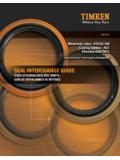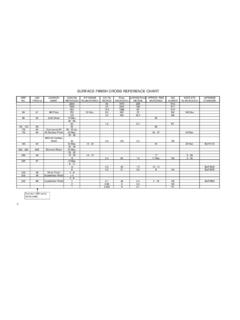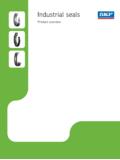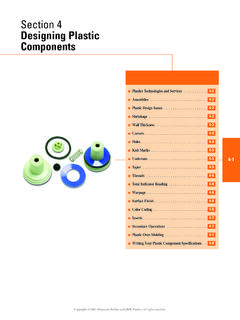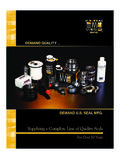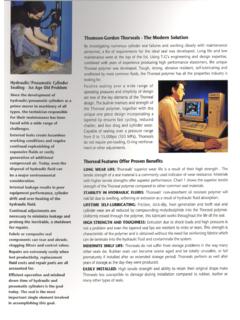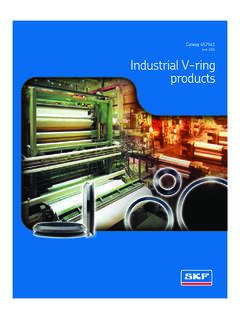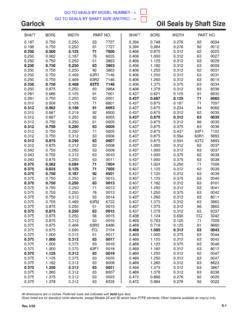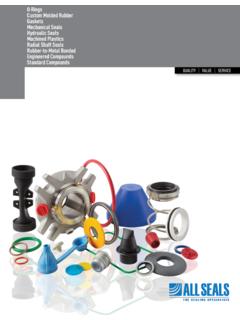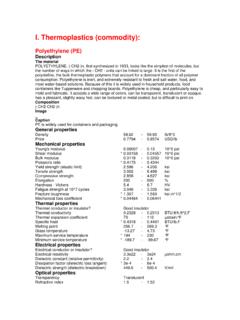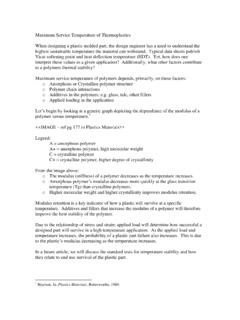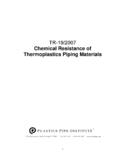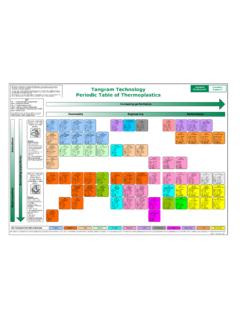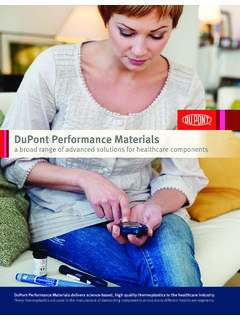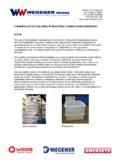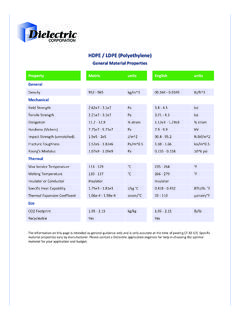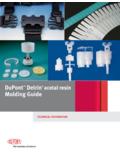Transcription of Plastic Material Selection Guide
1 Material Selection GUIDEThis selector Guide is intended to help you review the needs of your particularapplication and determine a few Material candidates that can then be the information and statements herein are believed to be accurate, no guarantee of their accuracy is made. The statements andinformation are included for reference purposes only and are not intended and should not be construed as either a warranty of any type orrepresentations applicable to the particular application, use or design of the buyer or user of the goods. In every case, we recommend thatthe purchaser or user before using or buying any product perform their own tests and make their own decision to determine to their own satisfaction whether the product is of acceptable quality, type and design and is suitable for the particular purposes under their ownoperating conditions. 1. GET IN THE RIGHT GROUPWHAT IS MOST IMPORTANT TO THE APPLICATION?AMORPHOUS THERMOPLASTICS Soften over a wide temperature range Good formability Transparency Poor chemical resistance Bond well using adhesives or solvents Prone to stress cracking Poor fatigue resistance Structural applications only (not suitable for bearing and wear)SEMICRYSTALLINE THERMOPLASTICS Sharp melting point Poor formability Opaque Good chemical resistance Difficult to bond using adhesives or solvents Resistant to stress cracking Good fatigue resistance Good for bearing and wear (as well as structural applications)IMIDIZED MATERIALS Best physical properties above 400 F Best temperature resistance Best bearing and wear capabilities Good chemical resistance POTENTIAL Material CHOICES ABS Acrylic Kydex Noryl PETG Polycarbonate Polystyrene (HIPS) Polysulfone PVC Radel R Ultem POTENTIAL Material CHOICES Acetal HDPE LDPE Nylon PBT PEEK PET Polypropylene PPS PTFE PVDF (Kynar )
2 UHMW-PEPOTENTIAL Material CHOICES PAI (polyamide-imide) Vespel Polyimide ShapesGENERAL GROUP CHARACTERISTICSMATERIAL Selection GUIDE2. CHOOSE THE BEST FAMILY IS TEMPERATURE A FACTOR? HOW CRITICAL IS COST?SEMICRYSTALLINETHERMOPLASTICSCost PPS PEEK PVDF (Kynar ) PTFE PET PBT Nylon Acetal UHMW-PE HDPE LDPE PolypropyleneTemperature Resistance (HDT) PPS Nylon Acetal PBT PVDF (Kynar ) PTFE PET Polypropylene HDPE LDPEHIGHESTLOWESTIMIDIZED MATERIALSCost Vespel Polyimide Shapes PAI (polyamide-imide)Temperature Resistance (HDT) Vespel Polyimide Shapes PAI (polyamide-imide)HIGHESTLOWESTMATERIAL Selection GUIDE3. COMPARE THE MECHANICAL PROPERTIES IS TENSILE STRENGTH (RESISTANCE TO BEING PULLED APART) IMPORTANT?AMORPHOUS THERMOPLASTICST ensile strength - pull apart (psi) Ultem 15,200 Polysulfone10,200 Radel R 10,100 Acrylic10,000 Noryl 9,600 Polycarbonate9,500 PETG7,700 PVC7,500 Kydex 6,100 ABS4,100 Polystyrene (HIPS)3,500 SEMICRYSTALLINE THERMOPLASTICST ensile strength - pull apart (psi) PEEK14,000 Nylon (6 cast)10,000-13,500 PPS12,500 Nylon (6/6 extruded)12,400 PET11,500 Acetal (Homopolymer)10,000 Acetal (Copolymer)9,800 PBT8,690 PVDF (Kynar )7,800 Polypropylene (Homopolymer)5,400 HDPE4,000 Polypropylene (Copolymer)3,800 UHMW-PE3,100 PTFE1,500-3,000 LDPE1,400 IMIDIZED MATERIALST ensile strength - pull apart (psi) PAI (polyamide-imide)21,000 Vespel Polyimide SP-112,500 Vespel Polyimide SP-219,500 Vespel Polyimide SP-38,200 Vespel Polyimide SP-227,500 Vespel Polyimide SP-2116,500 CROSS-SECTIONALAREA (SQ.)
3 IN.)ORIGINAL LENGTHLOAD (LBS.)LOAD (LBS.)CHANGE IN LENGTHMATERIAL Selection GUIDE4. COMPARE THE MECHANICAL PROPERTIESIS FLEXURAL MODULUS (BENDING STIFFNESS) IMPORTANT?AMORPHOUS THERMOPLASTICSF lexural modulus - stiffness (psi) Ultem (30% glass-filled)1,300,000 Polycarbonate(20% glass-filled)800,000 PVC481,000 Ultem 480,000 Acrylic480,000 Polysulfone390,000 Noryl 370,000 Radel R 350,000 Polycarbonate345,000 Kydex 335,000 Polystyrene (HIPS)310,000 PETG310,000 ABS304,000 SEMICRYSTALLINE THERMOPLASTICSF lexural modulus - stiffness (psi) PPS600,000 PEEK590,000 Nylon (6 cast)420,000-500,000 Acetal (Homopolymer)420,000 Nylon (6/6 extruded)410,000 PET400,000 Acetal (Copolymer)370,000 PBT330,000 PVDF (Kynar )310,000 Polypropylene (Homopolymer)225,000 Polypropylene (Copolymer)215,000 HDPE200,000 UHMW-PE110,000 PTFE72,000 LDPE30,000 IMIDIZED MATERIALSF lexural modulus - stiffness (psi) PAI (polyamide-imide)711,000 Vespel Polyimide SP-22700,000 Vespel Polyimide SP-21550,000 Vespel Polyimide SP-3475,000 Vespel Polyimide SP-211 450,000 Vespel Polyimide SP-1450,000 LOAD(LBS.
4 NEUTRAL AXIS(NO STRESS)SQUEEZINGSTRETCHINGMATERIAL Selection GUIDE5. COMPARE THE MECHANICAL PROPERTIESIS IZOD IMPACT (TOUGHNESS) IMPORTANT?AMORPHOUS THERMOPLASTICSIzod impact (notched) - toughness (ft-lbs/in) Kydex 18 Radel R 13 Noryl Polystyrene (HIPS) Ultem THERMOPLASTICSIzod impact (notched) - toughness (ft-lbs/in) LDPEno break Polypropylene (Copolymer) PVDF (Kynar ) Acetal (Homopolymer) Polypropylene (Homopolymer) Nylon (6/6 extruded) Acetal (Copolymer) Nylon (6 cast) MATERIALSIzod impact (notched) - toughness (ft-lbs/in) PAI (polyamide-imide) Vespel Polyimide Vespel Polyimide Vespel Polyimide Selection GUIDE6. COMPARE THE PROPERTIESIS DIELECTRIC STRENGTH (ELECTRICAL INSULATION) IMPORTANT?AMORPHOUS THERMOPLASTICSD ielectric strength - insulation (v/mil) Ultem 830 PVC544 Kydex 514 Noryl 500 Acrylic430 Polysulfone425 PETG410 Polycarbonate380 Radel R 360 SEMICRYSTALLINE THERMOPLASTICSD ielectric strength - insulation (v/mil) Nylon (6 cast)500-600 Acetal (Homopolymer)500 Acetal (Copolymer)500 PTFE400-500 PEEK480 PPS450 PET400 PBT400 Nylon (6/6 extruded)300-400 PVDF (Kynar )280 IMIDIZED MATERIALSD ielectric strength - insulation (v/mil) PAI (polyamide-imide)600 Vespel Polyimide SP-1560 VOLTAGEMATERIAL Selection GUIDE7.
5 THINK ABOUT THE APPLICATION - IS FDA COMPLIANCE IMPORTANT?AMORPHOUS THERMOPLASTICSFDA compliant grades available: Acrylic PETG Polycarbonate Polystyrene (HIPS) Polysulfone PVC Radel R Ultem SEMICRYSTALLINE THERMOPLASTICSFDA compliant grades available: Acetal HDPE LDPE Nylon PBT PEEK PET Polypropylene PTFE PVDF (Kynar ) UHMW-PESEMICRYSTALLINE THERMOPLASTICSGood chemical resistance: Acetal HDPE LDPE Nylon PBT PEEK PET Polypropylene PPS PTFE PVDF (Kynar ) UHMW-PEIMIDIZED MATERIALSGood chemical resistance: PAI (polyamide-imide) Vespel Polyimide ShapesSee pages 76-77 for more specific informationSee pages 76-77 for more specific information8. THINK ABOUT THE APPLICATION - IS CHEMICAL RESISTANCE IMPORTANT?The virgin, natural, unfilled formulations ofthe sheet, rod, tube, and film products listedhere are available from Curbell plastics , grades that comply with one or more of theFDA s guidelines for direct food contact atroom is important to specify FDA compliantmaterial at the time of the order to ensurethat FDA compliant Material is provided.

